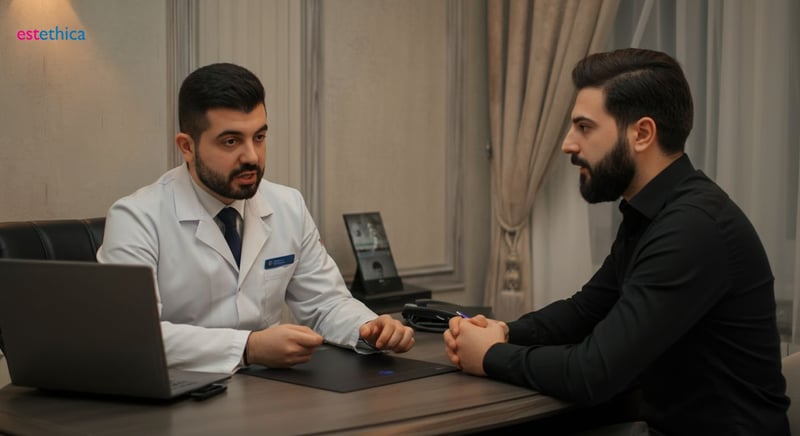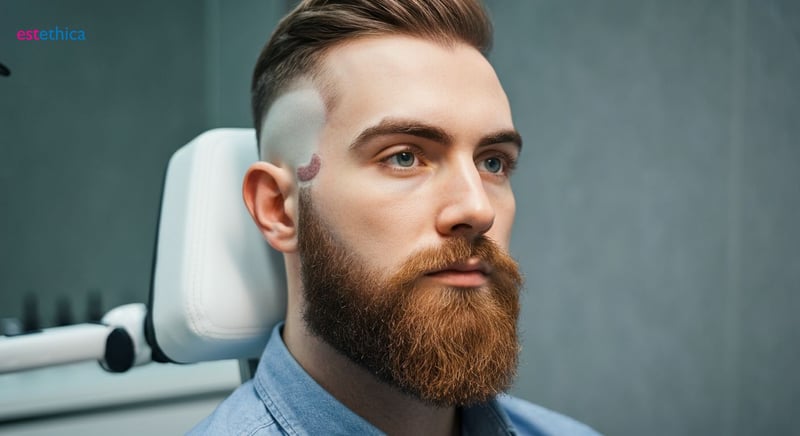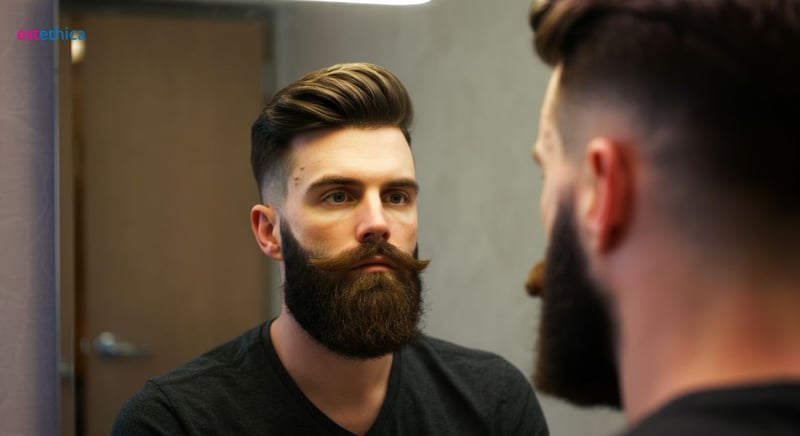Beard Transplant: Achieve the Perfect Facial Hair You've Always Dreamed Of
Unlock the secret to the perfect beard with estethica's state-of-the-art beard transplant procedures. Contact us today!
Are you considering enhancing your facial hair through a beard transplant? In recent years, beard transplants have become increasingly popular among men desiring a fuller, more defined facial appearance. With advanced techniques like Follicular Unit Extraction (FUE) and Follicular Unit Transplantation (FUT), achieving the beard of your dreams is now within reach. Through careful planning and expert execution, you can expect natural-looking and long-lasting results.
Understanding Beard Transplants: Is It Right for You?
Determining Candidacy for a Beard Transplant
A beard transplant is often seen as a transformative solution for those seeking enhanced facial hair. It’s important to consider several factors to ascertain if you’re a suitable candidate for this procedure. This is particularly relevant if you're experiencing patchy beard growth due to genetic predispositions or the lasting effects of scarring. The key lies in understanding the factors that contribute to the success of a beard or facial hair transplant. Consulting with a qualified surgeon is crucial to assess your facial hair characteristics. During the consultation, they will extensively evaluate factors such as hair density, skin elasticity, and the overall health of your donor area, often the scalp's back.
Key Steps in Assessing Your Candidacy
- Initial Consultation: Discuss your expectations and desired beard style with the surgeon. For instance, decide if you prefer a full beard or a more subtle enhancement.
- Donor Area Evaluation: The surgeon will assess the quality and availability of hair follicles, typically from the back of the scalp. Those with denser hair in the donor area are often better candidates.
- Health Assessment: A comprehensive health check-up ensures you have no underlying conditions that could affect the transplant's success. For example, uncontrolled diabetes could complicate the healing process.
The process involves a detailed examination and open discussion to align your goals with realistic outcomes. This thorough approach ensures that individuals considering a facial hair transplant are well-informed and prepared for the journey ahead. Approximately 85% of individuals who undergo a comprehensive evaluation are deemed suitable candidates for a successful beard restoration.

FUE vs. FUT: Exploring the Latest Beard Transplant Techniques
Understanding FUE and FUT Techniques
Choosing between Follicular Unit Extraction (FUE) and Follicular Unit Transplantation (FUT) is vital when considering a beard transplant at estethica Global. FUE involves extracting individual hair follicles directly from the donor area, typically the scalp, and then implanting them into the beard area. This precise method is known for leaving minimal scarring. Conversely, FUT involves removing a strip of tissue from the donor area, from which the hair follicles are then extracted. The FUT method may be more appropriate for individuals requiring a larger number of hair grafts. The selection between FUE and FUT often hinges on factors such as the area needing coverage and the quality of the donor's hair. Ultimately, the goal is to achieve natural beard growth through either technique.
Key Considerations for Choosing a Method
- Scarring: FUE generally results in less visible scarring compared to FUT, making it ideal for those who prefer shorter hairstyles post-transplant.
- Coverage Needs: FUT might be more suitable if extensive coverage is required. For individuals needing significant density, FUT can harvest a greater number of hair grafts in a single session.
- Recovery Time: FUE typically offers a quicker recovery period. The minimally invasive nature of FUE allows patients to resume normal activities sooner.
Each technique offers distinct advantages, and the "best" option varies based on individual needs and expectations. Choosing the right method ensures optimal results and satisfaction with the beard restoration process. Around 60% of beard transplant patients at estethica Global opt for the FUE method due to its less invasive nature and minimal downtime.

The Beard Transplant Journey: Recovery, Growth, and Aftercare
Optimizing Recovery After Your Beard Transplant
Post-transplant care is vital for the success of a beard transplant. Redness, swelling, and minor discomfort are typical immediately following the procedure. Adhering to the aftercare instructions provided by your healthcare provider is essential. These guidelines often include specific washing techniques and the application of prescribed ointments to prevent infection and promote healing. Proper care of the hair grafts during the initial days is crucial for their survival and integration. For example, avoiding touching or scratching the transplanted area can prevent dislodging the newly implanted follicles. Another critical aspect is maintaining hydration and consuming a nutrient-rich diet to support the body's natural healing processes. This multifaceted approach ensures the best possible outcome for your beard restoration.
Key Steps for Ensuring Optimal Beard Growth
- Gentle Cleansing: Use a mild, doctor-recommended shampoo to gently cleanse both the donor and recipient areas. This prevents infection and keeps the area free from crusting.
- Sun Protection: Avoid direct sun exposure to the transplanted area for at least a few weeks. If sun exposure is unavoidable, wear a wide-brimmed hat to protect your skin.
- Activity Restrictions: Refrain from strenuous physical activities for a specified period. High-intensity workouts can increase blood flow and potentially disrupt the healing process.

Achieving Natural-Looking Results: What to Expect from Your Beard Restoration
Achieving a Natural Look with Beard Restoration
The ultimate goal of a successful beard transplant is to create a result that seamlessly blends with your existing facial hair. The density, angle, and placement of the implanted hair grafts are meticulously planned to mimic natural facial hair growth. Skilled surgeons at clinics like estethica understand that each patient's facial hair is unique. They offer personalized approaches to ensure the results enhance their natural features. For example, when restoring a patchy beard, surgeons carefully distribute grafts to fill gaps while matching the direction of existing hair. The expertise in techniques such as Follicular Unit Extraction (FUE) is critical to achieving a natural-looking outcome. Proper aftercare, including potential supplemental treatments, plays a vital role in optimizing the density and texture of the transplanted beard, improving patient satisfaction with their beard restoration.
How to Maintain Natural Beard Appearance
- Regular Trimming: Regular trimming is essential to maintain the shape and length of your new beard. It helps the transplanted hair blend seamlessly with existing facial hair.
- Proper Grooming: Use beard oils and balms to keep the transplanted hair healthy and well-nourished. This promotes a natural texture and prevents dryness.
- Follow-Up Care: Attend all scheduled follow-up appointments with your surgeon. These check-ups allow for adjustments and ensure the long-term health and appearance of your beard.
Precision FUE and FUT Beard Transplants for Natural Facial Hair Restoration
estethica utilizes advanced Follicular Unit Extraction (FUE) and Follicular Unit Transplantation (FUT) techniques for beard transplants, ensuring precise extraction and implantation of hair follicles. These methods allow for customized beard designs that seamlessly integrate with a patient's natural facial features, providing a fuller, more defined appearance.
estethica's surgeons possess extensive experience in facial hair restoration, specializing in tailoring beard transplants to meet individual patient needs and aesthetic goals. A thorough consultation process is key, evaluating hair density, skin elasticity, and donor area health to determine the most suitable transplant technique for optimal, natural-looking results.
Comprehensive Aftercare for Optimal Beard Transplant Integration and Growth
estethica prioritizes patient well-being by providing detailed aftercare instructions and support following beard transplant procedures. This includes gentle cleansing techniques, sun protection guidance, and activity restrictions to ensure proper healing and graft integration, alongside a nutrient-rich diet recommendation.
Patients at estethica benefit from personalized pre- and post-operative support, ensuring a smooth and successful beard transplant journey. estethica is dedicated to maximizing patient satisfaction and achieving long-lasting, natural-looking results through comprehensive care and advanced techniques
Frequently Asked Questions
Am I a good candidate for a Facial Hair Transplant?
What are the key differences between FUE and FUT for Beard Restoration?
What does the recovery process look like after a Beard Transplant?
How can I ensure my Beard Transplant results look natural?
Discover your path to healthy beauty with estethica's world-class aesthetic and healthcare services.
📞 Call for a Free Consultation Today!